| dc.contributor.advisor | Soreghan, Michael | |
| dc.contributor.author | Miller, Elisha | |
| dc.date.accessioned | 2024-05-02T15:20:18Z | |
| dc.date.available | 2024-05-02T15:20:18Z | |
| dc.date.issued | 2024-05-11 | |
| dc.identifier.uri | https://hdl.handle.net/11244/340268 | |
| dc.description.abstract | The Lake Tanganyika rift is commonly cited as a modern analog for early stages of continental rifting. It lies within the western branch of the East African Rift system (EARS). The modern Tanganyika rift consists of distinct normal faults that alternate facing direction down the rift axis with footwall relief of < 1 km to > 2.5 km. Adjacent to faults, hanging wall subsidence has produced sub-basins with > 5 km of sediment fill. The age of rift initiation and uplift and subsidence along Lake Tanganyika is poorly constrained, however, and has mostly been inferred from the basin-fill, but these estimates are highly dependent upon assumptions of long-term rates of erosion and sediment accumulation. The lack of temporal constraints on the initiation and spatial variability of rifting within the Tanganyika rift has led to differing models posed for its formation: 1) the extensional uplift and associated subsidence initiated in the central part of the present rift and then propagated north and south over time, or 2) the extension initiated roughly coevally along the rift axis but differed in magnitude of extension along the rift axis. Testing these models requires better constraints on magnitude and timing of footwall uplifts along the rift. Low-temperature thermochronology can capture tectonic/erosional events by tracking the exhumation of minerals within rocks from depth following normal faulting through fission track analysis. Previous studies have applied low-temperature thermochronology in other rift segments of the western branch, but no studies have included the footwall uplifts of Lake Tanganyika. Here, I apply apatite fission-track (AFT) analyses to detrital river sand samples collected along two footwall uplifts along the Tanganyika rift axis to track rock cooling and to infer the associated exhumation history. Apatite fission-track analysis of these detrital samples yields a broad range of single-grain ages from Miocene (13 Ma) to Silurian (366 Ma) in central Lake Tanganyika and Eocene (41 Ma) to Neoproterozoic (842 Ma) in southern Lake Tanganyika. Watershed analysis of the sampled river in the central region exhibits a mature geometry in the central basin while the southern exhibits a younger morphology, with sediment sources occurring at higher elevations. The cooling age populations in central Lake Tanganyika are consistent with previous basement apatite fission-track ages from the Lake Albertine Rift to the north and Lake Malawi Rift to the south, all which are interpreted to result from Cenozoic rifting along rift flanks in the western branch. However, the southern sample captures cooling associated with Permo-Triassic to Cretaceous rifting. These AFT data suggest that rifting nucleated in the center basins then continued along the rift axis as opposed to coeval rift initiation along pre-existing shear zones across all subbasins in Lake Tanganyika. | en_US |
| dc.language | en_US | en_US |
| dc.rights | Attribution-NonCommercial-NoDerivatives 4.0 International | * |
| dc.rights.uri | https://creativecommons.org/licenses/by-nc-nd/4.0/ | * |
| dc.subject | Geology | en_US |
| dc.subject | Thermochronology | en_US |
| dc.subject | Rift Systems | en_US |
| dc.title | CONSTRAINING INITIATION OF RIFTING IN A MAGMA POOR SYSTEM: LAKE TANGANYIKA | en_US |
| dc.contributor.committeeMember | Jepson, Gilby | |
| dc.contributor.committeeMember | George, Sarah | |
| dc.date.manuscript | 2024-04-30 | |
| dc.thesis.degree | Master of Science | en_US |
| ou.group | Mewbourne College of Earth and Energy::School of Geosciences | en_US |

